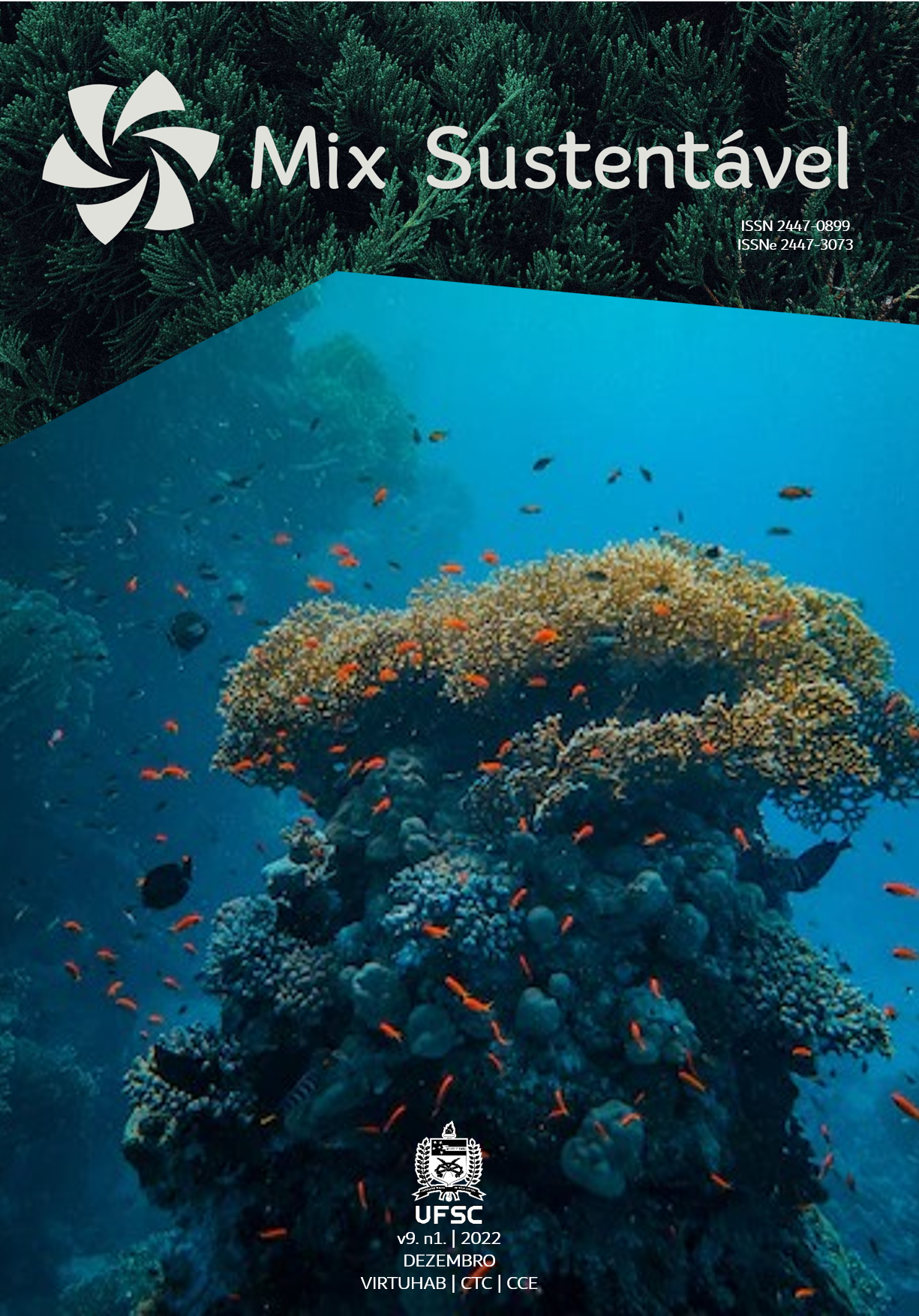ANÁLISE DO CUSTO DO CICLO DE VIDA DE CONCRETOS ECOAMIGÁVEIS COM AGREGADO RESIDUAL DE DEMOLIÇÃO E POZOLANA
LIFE CYCLE COST ANALYSIS OF ECO-FRIENDLY CONCRETE WITH RESIDUAL DEMOLITION AGREGATE AND POZZOLAN
DOI:
https://doi.org/10.29183/2447-3073.MIX2023.v9.n1.62-70Resumo
A construção civil destaca-se por ser um setor com elevado impacto ambiental. Nessa indústria, o concreto é um dos principais protagonistas devido ao grande volume empregado e a demanda de recursos naturais não renováveis para a sua produção. Diante disso, este trabalho objetiva estudar a sustentabilidade e o custo de diferentes alternativas de concreto eco amigáveis, compostos por dois tipos de cimento (CP IV e CP V-ARI), pozolana da cinza da casca de arroz (CCA) e teores distintos de resíduos de construção e demolição (RCD). Para isso, foram realizados ensaios de resistência à compressão axial e de carbonatação acelerada, que em conjunto à avaliação do ciclo de vida modular (ACV-m) e ao levantamento de custos, permitiu uma análise integrada comparativa das diferentes misturas de concreto em termos ambientais, econômicos e estruturais. A presença de RCD em misturas com CP IV não foi benéfica, uma vez que diminuiu consideravelmente a vida útil das amostras. Ao realizar a avaliação unitária de custo e de impactos ambientais, a mistura que continha maior concentração de RCD (30%) e cimento CP IV apresentou o pior desempenho. A substituição de cimento por CCA só foi positiva em misturas com baixo teor de RCD (até 15%).
Referências
UNEP; SETAC. United Nations Environmental Programme-Society Of Environmental Toxicology And Chemistry. Life cycle management: a business guide to sustainability. Paris, 51 p, 2007.
MEHTA, P.K. Reducing the Environmental Impact of Concrete, ACI Concrete International, 23 (10), pp. 61-66, 2001.
IPCC – Intergovernmental Panel On Climate Change. Climate change 2014: Mitigation of Climate Change. IPCC, 2014. Disponível em:<http://www.ipcc.ch/pdf/assessment-report/ar5/wg3/ipcc_wg3_ar5_full.pdf>.
Acesso em 03 de junho de 2021.
VON BAHR, B et al. Experiences of environmental performance evaluation in the cement industry. Data quality of environmental performance indicators as a limiting factor for Benchmarking and Rating. Journal of Cleaner Production. Pp 723-725, 2002.
PILLAI, R.G et al. Service life and life cycle assessment of reinforced concrete systems with limestone calcined clay cement (LC3). Cement and Concrete Research, 2018.
BRASIL. Conselho Nacional de Meio Ambiente. Resolução CONAMA nº. 307, de 5 de julho de 2002. Estabelece diretrizes, critérios e procedimentos para a gestão de resíduos da construção civil. Ministério do Meio Ambiente: CONAMA. Diário Oficial da União. Brasília, DF: Imprensa Oficial, 2002.
SCHAMNE, Annelise N.; NAGALLI, André. Reverse logistics in the construction sector: a literature review, The Electronic Journal of Geotechnical Engineering, v.21, pp. 691-702, 2016.
SINGH. B. Rice Husk – An Overview. Waste and Supplementary Cementitious Materials in Concrete. Indian Institute of Technology Roorkee, Roorkee, India, 2018.
MARTIRENA. F; MANZÓ. J. Vegetable ashes as Supplementary Cementitious Materials. Cement and Concrete Research, Vol 114, pp 57-64, 2018.
CONSELHO BRASILEIRO DE CONSTRUÇÃO SUSTENTÁVEL. Projeto ACV-m: Sustentabilidade na indústria de blocos e pavimentos de concreto: Avaliação de Ciclo de Vida Modular. p 94, 2014.
ITAMBÉ. Cimento. Curitiba, Itambé, 20 p, 2010.
SANTOS, Cristiane Carine. Concreto com Misturas de Agregado Residual de Construção e Demolição (RCD) e Pozolana, com Ênfase na Cabonatação. Dissertação de Mestrado – Universidade Federal de Santa Maria, Santa Maria, 2017.
NBR 5739. Concreto: Ensaios de compressão de corpos-de-prova cilíndricos. Rio de Janeiro: ABNT, 2007.
RILEM. Recomendations of TC 116-PCD. Tests for gas permeability of concrete. Materials and Structures. V. 32, 1999.
TCPO. Tabela de Composição de Preços para Orçamento. 13 edição. São Paulo, Pini, 2008.
INSTITUTO AÇO BRASIL. Relatório de Sustentabilidade. Instituto Aço Brasil, 49 p, 2013.
LAMBERTI, L. A. Análise do ciclo de vida e de custo de pilar com diferentes traços de concreto frente a carbonatação: do berço ao túmulo. Dissertação de Mestrado –Universidade Federal de Santa Maria, Santa Maria, 2015.
LAGERBLAD, B. Carbon Dioxide Uptake During Concrete Life Cycle – State of the art. Swedish Cement and Concrete Research Institute. CBI, 2006.
PADE, C ; GUIMARÃES, M. The CO2 uptake concrete in a 100 years perspective. Cement and Concrete Research. V 37, n 9, p 1348- 1356, 2007.
COLLINS, F. Inclusion of carbonation during life cycle of built and recycled concrete; influence on their carbon footprint. The International Journal of Life Cycle Assessment. V 15, n6, 2010.
NBR ISO 14040. Gestão ambiental: Avaliação do ciclo de vida: Princípios e estrutura. Rio de Janeiro,2014.
BRASIL. Sistema nacional de pesquisa de custos e índices da construção civil, 2015. Disponível em:< www.caixa.gov.br/sinapi>. Acesso em: 03 junho de 2021.
NBR 15575-1: Edificações habitacionais: desempenho: parte 1: requisitos gerais. Rio de Janeiro; ABNT, 2013.
PRÉ CONSULTANTS. SimaPro 7 Database Manual: Methods: Library. 67 p, 2016.
IPCC: Intergovernmental Panel On Climate Change. Climate change 2007: Mitigation of Climate Change. IPCC, 2007. Disponível em:< http://www.ipcc.ch/publications_and_data/publications_ipcc_fourth_assessment_report_wg3_report_mitigation_of_climate_change.htm >. Acesso em: 03 de Junho de 2021.
Downloads
Publicado
Edição
Seção
Licença
Copyright (c) 2022 Guilherme Danezi Piccini

Este trabalho está licenciado sob uma licença Creative Commons Attribution 4.0 International License.
Aviso de Direito Autoral Creative Commons
1. Política para Periódicos de Acesso Livre
Autores que publicam nesta revista concordam com os seguintes termos:
a. Autores mantém os direitos autorais e concedem à revista o direito de primeira publicação, com o trabalho simultaneamente licenciado sob a Licença Creative Commons Attribution que permite o compartilhamento do trabalho com reconhecimento da autoria e publicação inicial nesta revista.
b. Autores têm autorização para assumir contratos adicionais separadamente, para distribuição não-exclusiva da versão do trabalho publicada nesta revista (ex.: publicar em repositório institucional ou como capítulo de livro), com reconhecimento de autoria e publicação inicial nesta revista.
c. Autores têm permissão e são estimulados a publicar e distribuir seu trabalho online (ex.: em repositórios institucionais ou na sua página pessoal) a qualquer ponto após o processo editorial, já que isso pode gerar alterações produtivas, bem como aumentar o impacto e a citação do trabalho publicado (Veja O Efeito do Acesso Livre).




